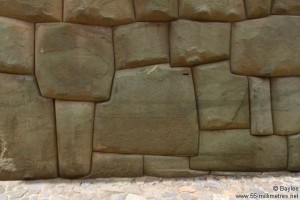quipu
Caral
Caral is an important site in the Supe Valley of central Peru near the coast and was part of the Norte Chico civilisation. It was occupied during the third millennium BC, although some push that back as far as the fourth millennium. Caral is claimed to be the oldest urban settlement in the Americas(a), although other sites in the region may challenge that. Arthur D. Faram has written a petroglyphic study of Caral(c).
A 2021 article from the History Channel suggests a date of around 2600 BC for the Caral complex and that it was abandoned about a thousand years later(d).
The 600-hectare site includes a pyramid complex that may have preceded those of the Egyptians. An early quipu was also found at the site suggesting some form of continuity with the later Inca civilisation.
In the 1950s, further south, in the Manchay Valley near the capital Lima, Karola Siebert was convinced that she had found Atlantean remains, while further south again, over the border in Bolivia we have Jim Allen’s chosen location for Atlantis near Lake Poopó.
A French website(b) has on offer the strange idea that the longitude of Caral in Peru and that of Xian in China and their respective relationships with the Prime Meridian at Greenwich and the longitude of Giza have some bearing on the location of Atlantis, which the author, Fabien Pardo, places in the Antarctic!
I reject all South American locations as possibly Atlantean and do so principally because the idea of an attack on Athens being launched from the west coast of South America, thousands of years ago, is, to put it kindly, just silly. However, it is quite clear that this region has had a fascinating prehistory and should keep archaeologists busy for generations to come.
(a) https://www.bibliotecapleyades.net/arqueologia/caral.htm
(b) ATLANTIS AND THE GREENWICH’S MERIDIAN – Site du livre – Pour Eux v1.618 – (archive.org) *
(c) https://migration-diffusion.info/article.php?id=344
(d) This Little-Known Peruvian Civilization Built Pyramids as Old as Ancient Egypt’s – HISTORY
Incas
The Incas or at least their ancestors are claimed by Jim Allen to have ruled Atlantis, which he insists exited on the Altiplano of the Andes in Bolivia. However, the idea of a connection between Atlantis and the cultures of Central and South America is not new, having been first mooted by Pedro Samiento de Gamboa in 16th century. Supporters of the theory today cite the extremely controversial Oera Linda Book which states that one of the Frisian naval commanders named Inka reached America after the destruction of Atlantis. With this tenuous etymological link they conclude that he was the founder of the Inca civilisation, ignoring the fact that the earliest evidence for the Inca tribe dates to around 1200AD while the Oera Linda Book puts the destruction of Atlantis circa 2200BC, leaving an unexplained gap of nearly 3500 years. A Frisian–Inca connection is also proposed on the Stepping Stones website(a) which for good measure endeavours to link them with the Shang Chinese, the Magyars and, of course, the Atlanteans(b).
The great tragedy of the Inca culture is that they left no written records with the exception of the knotted strings known as quipu (khipu)(d). Gary Urton is a Professor of pre-Columbian Studies and has a website dedicated to the study of quipu(e). In April 2017, Sabine Hyland published a paper on some late 18th century khipus made of animal hair, which according to local Peruvian villagers contained an account of an uprising against the Spaniards(g)(i).
But now, Urton and Alejandro Chu, of the Universidad Nacional Mayor de San Marcos in Lima have studied a collection of khipus at the Inkawasi site have concluded that the khipus in question probably recorded taxes levied on local crops(j).
 Leaving aside any consideration of an Atlantean link with the Inca people, there is no doubt that that the Incas possessed remarkable construction capabilities. It has been estimated that they constructed nearly 25,000 miles of roadway in a period of around 100 years(f)! This network, known as Qhapaq Ñan, extends over six countries and is now a Unesco World Heritage Site, the largest on the planet. Unfortunately it has been allowed to deteriorate. Efforts are being made to redress this unfortunate situation(h).
Leaving aside any consideration of an Atlantean link with the Inca people, there is no doubt that that the Incas possessed remarkable construction capabilities. It has been estimated that they constructed nearly 25,000 miles of roadway in a period of around 100 years(f)! This network, known as Qhapaq Ñan, extends over six countries and is now a Unesco World Heritage Site, the largest on the planet. Unfortunately it has been allowed to deteriorate. Efforts are being made to redress this unfortunate situation(h).
The megalithic masonry to be found in Cusco, their ancient capital, further highlights their outstanding construction abilities. A recent well-illustrated book by Brien Foerster, Lost Ancient Technology of Peru and Bolivia[923] examines a range of Incan sites and their often enigmatic monuments. This is a valuable addition to the literature on the subject.
In 2007 the Peruvian engineer and writer, Jesus Americo Huari Roman (1950-), wrote a book (for private circulation) entitled La Atlantida y el Imperio de los Incas (Atlantis and the Empire of the Incas), in which he also argues that then Incas were descendants of the Atlanteans. He has video clips on YouTube supporting his theory(a), unfortunately, with Spanish dialogue only.
(a) https://www.youtube.com/user/JESUSAMERICO100/feed
(b) https://all-ez.com/epigraphy.htm
(c) https://all-ez.com/frisian-inka.htm
>(d) http://enperublog.com/2009/06/30/unlocking-the-secrets-of-the-quipus/
(e) Researchers (archive.org)<
(g) https://www.sciencenews.org/article/twisted-textile-cords-may-contain-clues-inca-messages?tgt=nr
(h) https://www.bbc.com/travel/gallery/20170912-a-30000km-road-network-from-the-andes-to-the-amazon
(i) https://www.scientificamerican.com/article/unraveling-an-ancient-code-written-in-strings/
(j) https://www.sciencenews.org/article/khipus-knotted-cords-incas-taxes
